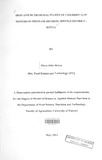Iron and nutritional status of children 12-59 months in Migwani division, Mwingi district, Kenya
Abstract
Poor nutritional status, anaemia, iron deficiency and iron deficiency anaemia among
children in many parts of Kenya continues to be public health issues especially in
arid and semi-arid lands which are generally food insecure. Available nutritional
status monitoring methods in Kenya do not capture adequate data for decision
making. The general objective of this study was to determine iron and nutritional
status and associated factors among children 12-59 months old in Migwani Division,
Mwingi, a district within arid and semi-arid lands of Kenya.
A cross-sectional study was conducted among 293 children (147 boys and 146 girls)
aged 12-59 months in January/ February 2010 in Migwani division, Mwingi district.
Nutritional status of the children was assessed using anthropometric indices and the
WHO 2005 child growth reference standards. Haemoglobin concentration was
determined using a haematological analyzer and anaemia defined as haemoglobin
concentration <110glL. Hb concentration and anaemia was adjusted for altitude and
ethnicity. Serum ferritin concentration was determined using enzyme linked
fluorescent immune assay- ALF A and iron deficiency was defined as serum ferritin
concentration <12 ug/l. Iron deficiency anaemia was defined as concurrent anaemia
and iron deficiency. Serum ferritin and iron deficiency was corrected for infection
using C-reactive protein which was determined using nyco card reader. SPSS version
16 and EPI info-ENA were used for data analysis. Multiple logistic regressions were
done to determine independent factors. Stepwise backward elimination method was
used to develop the best final models. Research was approved by Kenyatta National
Hospital Ethical Review committee.
Over half (54.1 %) of the subjects (48.0 - 60.1 C.I.) were stunted while 35.8% (30.7 -
41.4 CL) were underweight. These rates were higher than the national average as reported in the 2008/09 Kenya Demographic and Health Survey. The prevalence of
Global Acute Malnutrition was 10.3% (6.3 - 16.3 c.I.). Prevalence of anaemia before
and after adjusting for altitude and ethnicity was 34.5% and 16.7% respectively. The
prevalence of iron deficiency before and after correcting for infection was 23.0% and
29.5% respectively. Factors found to be independently associated with anaemia were:
birth order (OR=0.77; p=.001), age (OR=1.04; p=.0323), dietary diversity (OR=1.71;
p=.001), stunting (OR=4.28; p=.0007) and iron deficiency (OR=4.23; p=.0006). Age
(OR=I.06; p=.000)was independently associated with iron deficiency while factors
independently associated with iron deficiency anaemia were age (OR=1.05; p=.024)
and birth order (OR=0.79; p=0.006). Breastfeeding status (OR=0.35; P=.012),
stunting (OR=49.47; p=.000)and wasting (OR=152.17; p=.000)were independently
associated with Underweight. Underweight (OR=14.67; p=.000) was independently
associated with stunting while factors independently associated with wasting were
age (OR=1.04; p=.036) and underweight (OR=25.51; p=.000).
We conclude that anaemia status among children in Migwani is of mild public health
significance (5.0-19.9%) while global acute malnutrition is a serious public health
issue (10-14%) according to World Health Organization classification. Low birth
order, young age, low dietary diversity, stunting and iron deficiency are risk factors
to anaemia. Young age is risk to iron deficiency. Young age is a risk factor while low
birth order is a protective factor to iron deficiency anaemia. Underweight is
associated with stunting while young age and underweight are risk factors to wasting.
Breastfeeding children were protected from underweight while stunting and wasting
are risk factors to underweight.
The households and community members should improve care and support of
children while the government and NGOs should put/improve mechanisms in place to prevent and correct the problem of stunting, anaemia and iron deficiency such as
promotion of exclusive breastfeeding and dietary diversification. There is need to
strengthen nutrition status monitoring in the area in order to implement timely and
evidence based interventions.
Sponsorhip
University of NairobiPublisher
Department of Food Science, Nutrition & Technology, University of Nairobi

